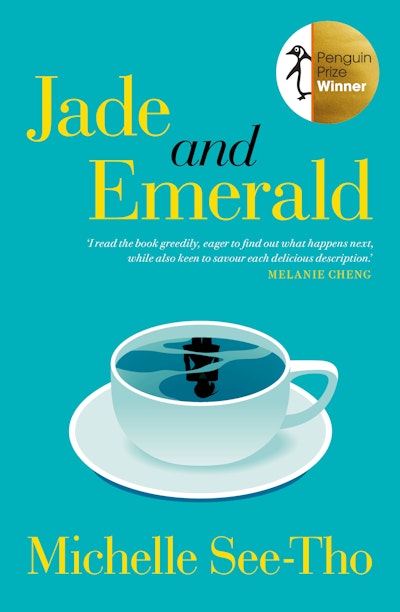
- Free Article: No
- Contents Category: Fiction
- Review Article: Yes
- Article Title: Echoes of truth
- Article Subtitle: A classic novel of manners
- Online Only: No
- Custom Highlight Text:
In the opening pages of Michelle See-Tho’s début novel, Jade and Emerald, an unnamed narrator is avoiding someone’s gaze. That someone is ‘pristine, poised like a goddess’ to the narrator’s vision of herself: haircut ‘like an eight-year-old boy’s’, smudged make-up, dress the wrong colour. There is a secret between these two young women, blown open by the prologue’s end.
- Featured Image (400px * 250px):

- Alt Tag (Featured Image): Giselle Au-Nhien Nguyen reviews ‘Jade and Emerald’ by Michelle See-Tho
- Book 1 Title: Jade and Emerald
- Book 1 Biblio: Vintage, $34.99 pb, 336 pp
- Book 1 Cover Small (400 x 600):

- Book 1 Cover (800 x 1200):

Lei Ling and Gigi develop a mentor-mentee relationship. Thus begins a double life. At home, Lei Ling is a latchkey child, studying violin (with hopes of joining the Melbourne Symphony Orchestra) and helping her mother to cook every night. With Gigi she is Chanel, a promising young woman with luxurious taste and an appreciation of the finer things in life.
Through Gigi, she sees the possibility of a different future: ‘I wished that I could be older, independent and in charge of my life. I wished that I could be rich and powerful and impervious to pain.’ She develops a heightened disdain for her mother, who represents an uncultured, parochial world she wants to leave behind.
Jade and Emerald is a classic novel of manners, splitting its young narrator-protagonist between these two disparate worlds, and inching closer to the divide that opens the story. Class is a primary concern, intersecting often with race. See-Tho asks what a person of colour must do to be seen as sophisticated or even worthy. Lei Ling learns this early when, upon meeting Gigi, the older woman tells her, ‘You should give yourself an English name. Especially if you live in a Western country.’ Later, she tells her mother, ‘I want a Western name … a normal name.’
Lei Ling’s rigorous violin training has echoes of Jena Lin, the troubled, self-destructive protagonist of Jessie Tu’s A Lonely Girl is a Dangerous Thing (2020). In both novels, there is the migrant’s longing for upward social mobility, manifested through participation in a world with high social and cultural capital. It is not a stretch to see a character like Jena as a logical progression for Lei Ling, under the weight of parental and cultural expectation.
Yet there are aspects that do not feel realistic. Would Angela, the daughter of wealthy parents who go out of their way to advertise their social status (every child who attends her birthday party receives a Game Boy), really go to a state school? The world Lei Ling enters through Gigi feels exaggerated, bordering on fantastical. Perhaps that is the point, to show the stark difference between these two modes of being through the eyes of an adolescent who is still coming to an understanding of life.
The novel has much in common with Alice Pung’s One Hundred Days (2021), particularly in the liminality of its genre: it blends elements of literary fiction with the tropes and language of young adult fiction to explore the heady tensions of adolescence, exacerbated through third-culture alienation.
The mothers in both novels are cold, clinical, and often emotionally abusive, but the daughters come to understand the trauma and sacrifice that has made them so. This narrative trajectory is common to the point of cliché in diasporic fiction; the tiger mother, in particular, is a well-worn trope, signified in Lei Ling’s thought: ‘My mother was so controlling and seemed determined to ruin my life.’
Using Gigi as a foil is Jade and Emerald’s point of difference, but there is a tension in the nature of Lei Ling’s relationship with Gigi. What does the older woman want from a random young girl? Gigi’s provision of expensive gifts has a sense of disquiet about it – the threat of grooming is never distant. The power in the relationship is inherently unbalanced, so even when Gigi’s relatively benevolent motivations are revealed, the discomfort never completely dissipates.
The 1990s setting provides both nostalgia and levity: Lei Ling is a devoted fan of the television show Sabrina the Teenage Witch, and uses it as a yardstick for how Western people might react or behave. It is also an effective tool to illustrate the claustrophobia of the pre-internet age, as when Lei Ling has to secretly read fashion magazines at the library to catch a glimpse of what exists outside her immediate surroundings.
Food as metaphor is another frequent feature of this type of writing. While this, too, can often veer into stereotype, See-Tho’s version is charming: Lei Ling’s embarrassed face ‘felt as if it had been rubbed with Sichuan peppercorns’; creases in a character’s forehead are like ‘pinched dumpling pleats’; limbs ‘softened like noodles in hot water’. These vivid descriptions link Lei Ling’s outer world to something inescapable within, and carry the reverberations of the rituals she performs with her mother. In these visions, that bond is everywhere.
A tragedy brings mother and daughter closer together and unfurls the complexities of Jing Fei’s life to culminate in the novel’s emotional denouement. The threads seem to be tied too conveniently, with some melodramatic flourishes to boot. But there are echoes of truth and pain throughout this novel, which delves into the way that class tensions of the diaspora can cause confusion in a third-culture child who is simply trying to belong.


Comments powered by CComment